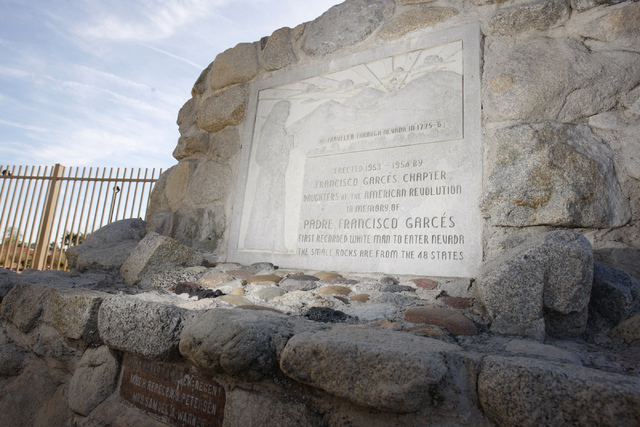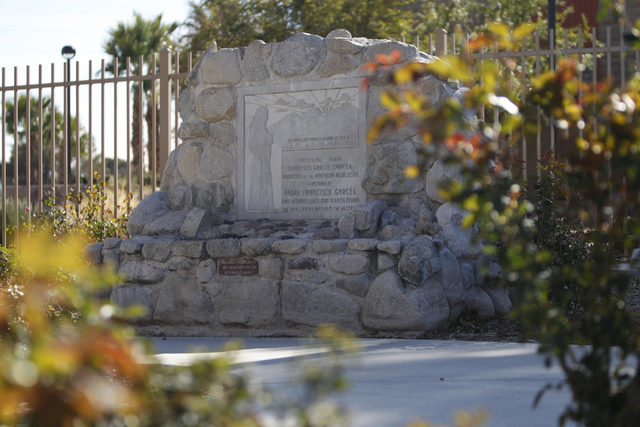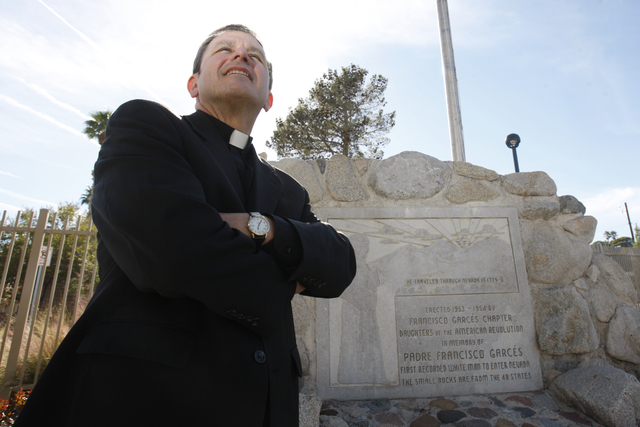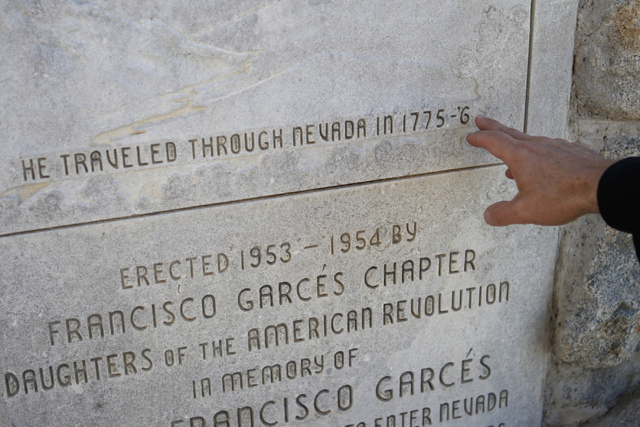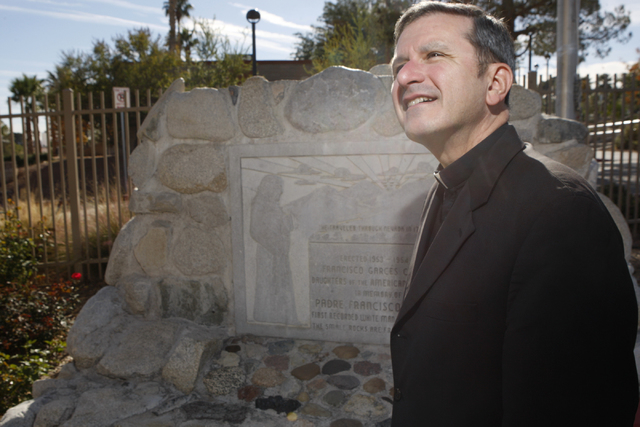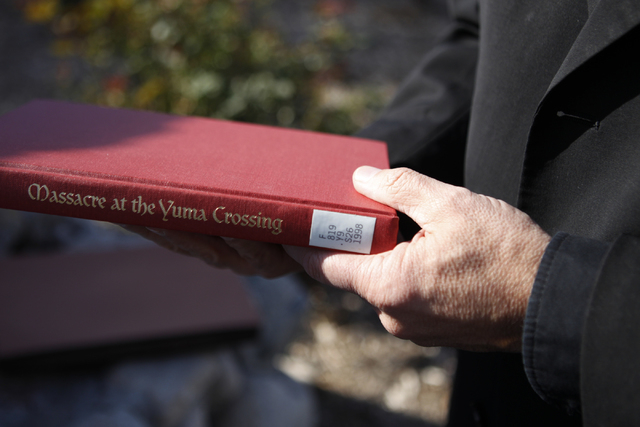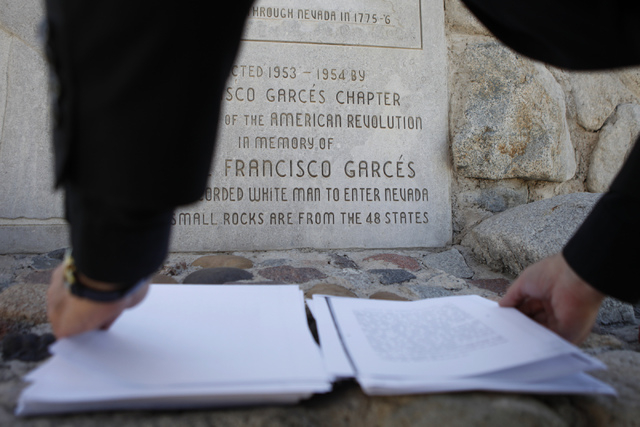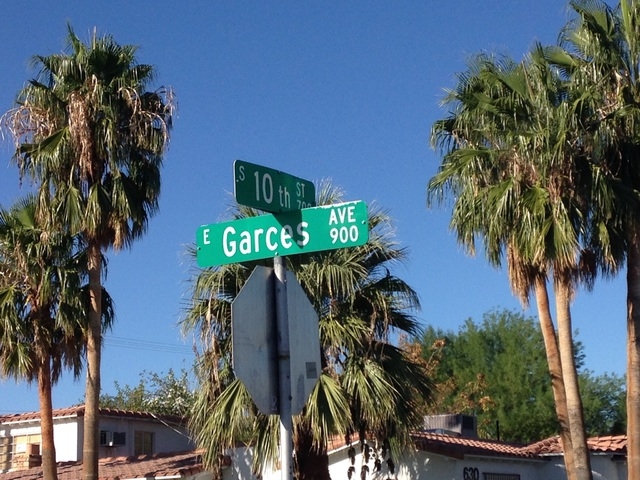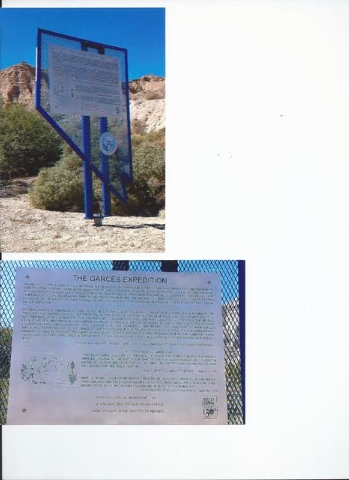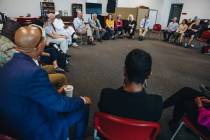Marker honoring Garces, first European in Nevada, back after 15 years
Dead for 233 years. Gone for just 15 — but that’s the absence that stings.
Illogical as this sounds, the math adds up for Friar Francisco Hermenegildo Tomas Garces.
“It’s not often that you can say the first non-Native American to pass through a state was a Catholic priest, so that’s one reason for my passion,” said Monsignor Gregory Gordon, pastor of St. Anne Catholic Church, who spearheaded a drive to replace a historical state marker honoring the priest’s place in Nevada history, which went MIA 15 years ago.
“He had a mission to bring Christianity to the Mojave Indians,” Gordon said. “He was an explorer and an adventurer.”
Rugged guy, this Franciscan friar from northern Spain, who might sound familiar from the downtown street that bears the name Garces. So does a plaque at Lorenzi Park, reflecting the local chapter of the National Society of the Daughters of the American Revolution that was christened for him in 1950. Yet the most prestigious tribute to the first white man to cross into what is modern-day Nevada in 1776 — the official marker at State Route 163 and U.S. Highway 95 near Laughlin, four miles from the California state line — disappeared into municipal limbo.
Trace it back to a highway-widening project by the Nevada Department of Transportation, during which the marker was shipped to an NDOT yard in Searchlight, then bounced among various department yards until it simply … vanished.
“The importance of the Garces marker has always been immeasurable, and its loss during this time was a true shame,” said Paul Sebesta, a historian, researcher and operator of the website, www.nevada-landmarks.com.
“The Nevada history taught in our schools is one thing. Seeing history’s representation on a historic marker, in the wilds of Nevada, is another. Reading an old tale such as Garces’ crossing, completely engrossed by surrounding stark mountains, beats reading about it in a cold classroom any day of the year.”
Now it’s back. The new marker is closer to where Garces actually traveled in Nevada, Gordon said. It is along the Needles Highway south of Laughlin at Mile Marker 5.1. It is about two miles south of Laughlin and two miles north of the Avi Resort turnoff in the Fort Mohave Indian Reservation, which has its own Garces marker, he added.
“He really did live an extraordinary life in a variety of ways that most people don’t know about,” said Gordon, who provided updated text on the marker that was erected about two weeks before the sesquicentennial in October. A ribbon cutting at the marker and a prayer service at St. John the Baptist Catholic Church in Laughlin are being planned for early March, the anniversary of when Garces was in the Mojave villages.
“On the marker, we were able to put the two entries that this priest wrote in his diary,” Gordon said. “When it comes to historical documentation within the present boundaries of the state of Nevada, these might be the two oldest written records, if you exclude petroglyphs. It really is something to be proud of.”
Assigned to the Mission San Xavier del Bac in the Sonoran Desert (near what is now Tucson, Ariz.), Garces became a key player in the exploration of the Sonoran, Colorado and Mojave deserts, the Gila River and the Colorado River, where he arrived seeking a new land route to the Pacific Ocean.
“The Native American village he wandered onto was the first one he’d seen in the region,” Sebesta said. “The natives’ hospitality was beguiling, and Garces no doubt took them up on their offer to lead him farther west to California. It is then that Garces crossed the river, officially … stepping foot onto what would later become Southern Nevada.”
Determined to restore state-sanctioned recognition of Garces’ journey, Gordon addressed it during a Mass for the St. Thomas More Society of Nevada, an association of local Roman Catholic attorneys, judges and community leaders. That stirred the interest of society member and history buff Jim Butman, who was raised in Las Vegas and decided to research Garces’ life.
“If you look downtown, you see the streets are laid out as Ogden, Bonneville, Lewis, Clark and Garces, and they are all explorers,” Butman said, noting that he was aware of Ogden’s and Bonneville’s history as fur trappers, and Lewis and Clark’s expedition under President Thomas Jefferson. “But Garces was a mystery,” he said. “Then I found out he was a missionary and explorer who got his commission from the viceroy of Spain to find this land trail to the missions that became Baja, California and Mexico.”
Intrigued, Butman called Rebecca Palmer, administrator at the State Historic Preservation Office in Carson City, who contacted NDOT, their partner in the marker program that is responsible for their erection and maintenance. Yet a joint investigation yielded … nothing.
“NDOT very graciously stores them in their yards, but sometimes they are sitting there and sometimes they’re not,” Palmer said. “I couldn’t tell you where it might have gone to. It could still exist somewhere in a location we didn’t investigate. But that doesn’t matter. Once we determined it was no longer extant in any place we could identify, we went about re-creating and rebuilding it.”
Its loss isn’t an isolated incident. Of the 271 markers throughout the state, Sebesta said that 29 are missing. “It’s fair to say that road construction is a huge culprit in these cases,” said Sebesta, who explained that markers are removed during highway projects to ensure their safety, but NDOT occasionally fails to re-erect them and they’re lost in transit from NDOT yards to garages operated by private contractors.
“It has good intentions,” Sebesta said, “but it backfires quite a bit around the state.”
However it happened, the disservice has been corrected for Garces, who lost his life in the service of exploration and the spreading of Christianity in what is known as the Yuma Uprising.
Garces and his fellow friars established two mission churches along the Colorado River at Yuma Crossing in 1779 as part of a new Spanish settlement in the territory of the Quechan Native-American tribe. Soon, though, the settlers began violating the treaty with the Quechans, raiding their crops and farmlands. During the resulting revolt in 1781 Garces and his colleagues were killed. They are considered martyrs by the Catholic Church.
“Sometimes all that remains of a grand tale in Nevada rests solely within the texts of an historic marker. If that marker goes bust, what happens to history then?” Sebesta asks.
“The importance of Garces isn’t unlike the explorations of John C. Fremont, Joseph Walker, Jedediah Smith — even our immigrant cousins such as the Donners, the Bartlesons and the Applegates. This history is vital to Nevada itself. If anything, Garces needed this marker as much as we needed it.”



